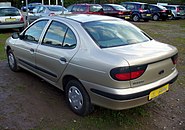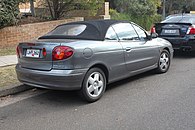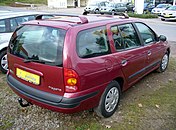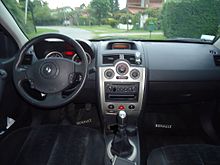
A | B | C | D | E | F | G | H | CH | I | J | K | L | M | N | O | P | Q | R | S | T | U | V | W | X | Y | Z | 0 | 1 | 2 | 3 | 4 | 5 | 6 | 7 | 8 | 9
This article includes a list of general references, but it lacks sufficient corresponding inline citations. (February 2023) |
| Renault Mégane | |
|---|---|
 | |
| Overview | |
| Manufacturer | Renault |
| Production | 1995–present (LHD) 1996–2022 (RHD) |
| Body and chassis | |
| Class | Small family car (C) |
| Body style | 3 or 5-door hatchback 4-door sedan/saloon 5-door estate 2-door coupé-cabriolet |
| Layout | Front-engine, front-wheel-drive |
| Chronology | |
| Predecessor | Renault 19 |
| Successor | Renault Megane E-Tech Electric |
The Renault Mégane (French pronunciation: [meɡan]), also spelled without the acute accent as Megane,[1] especially in languages other than French, and also known as the Renault Megavan for an LCV in Ireland, as the Renault Scala in Iran and as the Renault Mégane Grandcoupé for the saloon in Israel, Palestinian Authority and Serbia for certain generations,[2][3][4][5] is a small family car produced by the French car manufacturer Renault for the 1996 model year, and was the successor to the Renault 19. The Mégane has been offered in three- and five-door hatchback, saloon, coupé, convertible and estate bodystyles at various points in its lifetime, and having been through four generations is now in its fifth incarnation.
The first generation was largely based on its predecessor, the 19, and utilized modified versions of that car's drivetrain and chassis. The second and third generations were based on the Renault–Nissan C platform. The fourth generation is based on the CMF-CD platform, as used by the Renault Talisman and Renault Scénic.
In November 1996, the Mégane Scénic compact MPV was introduced, using the same mechanical components as the hatchback Mégane. For 2002, the Mégane entered its second generation with a substantial redesign taking place, and was voted European Car of the Year for 2003, whilst also becoming the first car in its class to receive a five star Euro NCAP rating.
The Mégane entered its third generation in 2008, with another totally different design being used; the saloon version of the Mégane became known as the Renault Fluence for this generation, and it was introduced in 2009. The fourth-generation Mégane was launched in 2015, with sales commencing in 2016.
In 2021, Renault revealed a battery electric version known as the Megane E-Tech Electric, which takes on a crossover exterior design.
First generation (X64; 1995)
| Mégane I | |
|---|---|
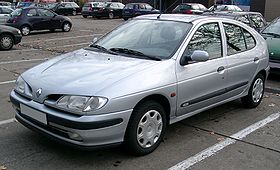 | |
| Overview | |
| Also called | Renault Megavan (LCV, Ireland) |
| Production | July 1995–2003 1996–2009 (Argentina) 2000–2009 (Colombia) |
| Model years | 1996–2003 |
| Assembly |
|
| Designer | Michel Jardin (1991)[6] Patrick Le Quément (1991, 1992)[7] |
| Body and chassis | |
| Body style | 4-door saloon 2-door coupé 5-door hatchback 2-door convertible 5-door estate |
| Related | Renault Scénic Renault 19 |
| Powertrain | |
| Engine | Petrol: 1.4 L E7J I4 1.4 L K4J I4 1.6 L K7M I4 2.0 L F3R I4 2.0 L F5R I4 2.0 L F7R I4 Diesel: 1.9 L F8Q D I4 1.9 L F8Q dT I4 1.9 L F9Q dTi I4 1.9 L F9Q dCi I4 |
| Transmission | 4-speed automatic 5-speed manual |
| Dimensions | |
| Wheelbase | Hatchback, Sedan & Wagon: 2,580 mm (101.6 in) Coupé & Convertible: 2,468 mm (97.2 in) |
| Length | Hatchback: 4,129–4,164 mm (162.6–163.9 in) Sedan: 4,436–4,400 mm (174.6–173.2 in) Wagon: 4,437 mm (174.7 in) Coupé: 3,931–3,967 mm (154.8–156.2 in) Convertible: 4,081 mm (160.7 in) |
| Width | 1,698–1,699 mm (66.9–66.9 in) |
| Height | 1,365–1,420 mm (53.7–55.9 in) |

Development of the X64 began at the beginning of 1990, with the first sketches of X64 programme being drawn during the first six months of 1990. Very quickly, several themes were outlined and developed into four small scale (1/5) models by September 1990.
The designs retained were developed around four themes. Theme A: a six light version, evoking the Laguna; Theme B: a model with a markedly cuneiform line; Theme C: another design with ellipse shaped glasswork and rear notch; Theme D: a model with the same elliptical glazing and rounded rear.

In March 1991, all four styling proposals were developed into full scale (1:1). Theme C by Michel Jardin was chosen by Le Quement and frozen for production in April 1992. The first prototypes were built and presented to management in December 1992. Approximately 432 prototypes were built (at Rueil assembly) and destroyed during development.
In June 1993, Renault purchased production tooling for the X64, with the first test unit being assembled at the Douai plant in October 1994, and pre production units being constructed from December 1994 to the middle of 1995.
The Mégane I was unveiled in September 1995, at the Frankfurt Motor Show, as a replacement for the Renault 19. The car was essentially a reskin of its predecessor, and carried over the 19's floorpan, engines, transmissions and chassis design, albeit with much modification.
Taking its name from a Renault concept car shown in 1988, the Mégane further developed the new corporate styling theme introduced by Patrick Le Quément on the Laguna, most notably the "bird beak" front grille – a styling cue borrowed from the Renault 16 of the 1960s. Renault decided to add an acute accent to the vehicle name (Mégane), in order to assert its European identity, in a context of growing competition of newer car manufacturers coming from Japan.[8]
As with the 19 and the 11 before it, the Mégane was produced at Renault's Douai plant in northern France starting in July 1995, and at the Spanish plant of Palencia. Market launch began on 15 November 1995 in France, and 15 December 1995 for the coupé. Sales in the United Kingdom commenced in April 1996.
Safety was a key focus of the Mégane I, Renault's first car reflecting their new focus of selling on safety.
It featured a pillar mounted three-point seatbelt for the middle rear occupant (replacing the common 'lap strap'), standard front belt pre tensioners and load limiters, driver's airbag (passenger airbag from 1996) and an impressive safety structure – a specification ahead of all rivals in 1995, e.g. VW Golf Mk 3, Opel Astra F, Ford Escort etc. Some features, such as the three-point middle belt, had debuted on the Renault 19 safety concept vehicle (and this feature entered production on the Renault Laguna before the Mégane).
The car also benefited from Renault's first "System for Restraint and Protection" (SRP), essentially a system of careful optimisation of occupant restraint by interaction of the seat, seatbelt, pretensioner, load limiter and airbag. The Mégane I achieved a best in class four star crash test rating in the 1998 round of testing by Euro NCAP.[9]
November 1996 saw the introduction of the Mégane Scénic compact MPV.
Power came from the Renault E type ("Energy") engine in 1.4 L and 1.6 L, and the F-type unit in both 1.9 L diesel and 2.0 L petrol forms, although this time around there was a wider variety of 16 valve derivatives. A 1.9 L diesel engine in both normally aspirated and turbocharged forms was also available.
Renault also produced a limited number of Renaultsport edition Phase 1's with the Renaultsport bodywork; however, these were very rare. The Renaultsport kit was available to purchase for a short time direct from Renault France, but has now been discontinued, thus their value has increased.
The estate version of the original Mégane was only available in LHD form, with no RHD variants built. This could be due to the greater popularity of the Scenic in those markets, limiting the potential sales of a compact estate. The estate was added with the facelift of 1999, although pre-facelifted Mégane estates were sold from September 1998 in Turkey, where it was manufactured by Oyak-Renault.[10][11][12]
In Japan, Renault was formerly licensed by Yanase Co., Ltd., but in 1999 Renault acquired a stake in Japanese automaker Nissan. As a result of Renault's purchase, Yanase canceled its licensing contract for all Renault models sold in Japan, including, but not limited to, the Mégane I, in 2000, and Nissan took over as the sole licensee for Renault cars.[citation needed]
Facelift
A mild facelift in spring 1999 gave the Mégane I a modified grille, more advanced safety features and upgraded equipment, and 16 valve engines were used across the range. An Estate body style was also launched in mainland Europe with the facelift. The production continued for the Latin America Market, where it was sold alongside the Mégane II line at a considerably lower price until 2011.
-
Pre-facelift Renault Mégane five-door
-
Pre-facelift Renault Mégane Classic sedan
-
Pre-facelift Renault Mégane Coupé
-
Pre-facelift interior
-
Post-facelift Renault Mégane five-door (hatchback)
-
Post-facelift Renault Mégane five-door (hatchback)
-
Renault Mégane Coupé (facelift)
-
Post-facelift Renault Mégane (convertible)
-
Post-facelift Renault Mégane (estate)
-
Post-facelift Renault Mégane Classic sedan
-
 Post-facelift 1999 Renault Megane Coupe
Post-facelift 1999 Renault Megane Coupe
South America
In countries, such as Argentina and Colombia, the Mégane I was available until 2010, sold as a sedan and an estate, but in Venezuela, it was available only as a sedan. It features as the top line of the model the LA04 engine (16 valves, 1.6 litres and 110 HP), and was produced by both Renault Colombia and Renault Argentina, in where it was one of the best selling cars to date.
It is a car with more advanced safety features, upgraded equipment and more. The Mégane I had a lower price than the Mégane II.
In Venezuela, it was only available in one version: Unique, with a five-speed manual gearbox or a four-speed automatic one. Both of these were equipped with Abs and other extra equipment including driver and passenger front airbags, foglights, leather seats, electric mirrors and electric windows. In Argentina, not every version had features such as electric windows, electric mirrors or airbags.
Engines
| Model | Displacement | Type code | Power | Top speed | 0–100 km/h (0–62 mph) (s) |
|---|---|---|---|---|---|
| 1.4 8v Eco | 1,390 cc (84.8 cu in) | E7J | 70 hp (52 kW) | 168 km/h (104 mph) | 14.5 |
| 1.4 8v | 1,390 cc (84.8 cu in) | E7J | 75 hp (56 kW) | 170 km/h (106 mph) | 13.8 |
| 1.4 16v | 1,390 cc (84.8 cu in) | K4J | 98 hp (73 kW) | 184 km/h (114 mph) | 11.8 |
| 1.6 8v | 1,598 cc (97.5 cu in) | K7M | 90 hp (67 kW) | 184 km/h (114 mph) | 11.5 |
| 1.6 16v | 1,598 cc (97.5 cu in) | K4M | 110 hp (82 kW) | 195 km/h (121 mph) | 9.8 |
| 1.8 16v | 1,783 cc (108.8 cu in) | F4P | 120 hp (89 kW) | 198 km/h (123 mph) | 9.5 |
| 2.0 8v | 1,998 cc (121.9 cu in) | F3R | 115 hp (86 kW) | 197 km/h (122 mph) | 9.7 |
| 2.0 16v | 1,998 cc (121.9 cu in) | F4R | 139 hp (104 kW) | 213 km/h (132 mph) | 8.6 |
| 2.0 16v | 1,998 cc (121.9 cu in) | F7R | 150 hp (112 kW) | 215 km/h (134 mph) | 8.6 |
| 2.0 16v IDE | 1,998 cc (121.9 cu in) | F5R | 140 hp (104 kW) | 213 km/h (132 mph) | 8.6 |
| 1.9 8v D Eco | 1,870 cc (114.1 cu in) | F8Q | 65 hp (48 kW) | 160 km/h (99 mph) | 17.8 |
| 1.9 8v TD | 1,870 cc (114.1 cu in) | F8Q | 95 hp (71 kW) | 178 km/h (111 mph) | 12.6 |
| 1.9 8v dTi | 1,870 cc (114.1 cu in) | F9Q | 80 hp (60 kW) | 170 km/h (106 mph) | 13.8 |
| 1.9 8v dTi | 1,870 cc (114.1 cu in) | F9Q | 100 hp (75 kW) | 183 km/h (114 mph) | 12.3 |
| 1.9 8v dCi | 1,870 cc (114.1 cu in) | F9Q | 105 hp (78 kW) | 189 km/h (117 mph) | 11.5 |
Maxi Mégane
| Renault Maxi Mégane | |
|---|---|
 | |
| Overview | |
| Manufacturer | Renault Sport |
| Assembly | France |
| Body and chassis | |
| Class | F2 Kit Car |
| Body style | 2-door coupé |
| Layout | FF layout |
| Platform | Renault Mégane I |
| Related | Renault Megane I |
| Powertrain | |
| Engine | 2.0 L F7R710 I4 |
| Transmission | 7-speed sequential manual |
| Dimensions | |
| Length | 3,952 mm (155.6 in) |
| Width | 1,823 mm (71.8 in) |
| Height | 1,360 mm (53.5 in) |
| Curb weight | 960 kg (2,116 lb) |
| Chronology | |
| Predecessor | Renault Clio Williams Maxi |
During the 1990s, Renault Sport developed a rally car for the Formula 2 Kit Car regulations. This was the Clio Williams Maxi, which was the first car truly developed for the F2 Kit Car category, and first appeared in 1996. However, rivals such as Citroën and Peugeot soon introduced bigger and more powerful cars, which resulted in Renault producing an F2 version of the Mégane in 1996. The Maxi Mégane officially represented the brand in French Championship rallies in 1996 and 1997 with drivers like Philippe Bugalski, Jean Ragnotti or Serge Jordan, and the British Rally Championship from 1996 to 1999, with Grégoire De Mévius, Alain Oreille, Robbie Head, Martin Rowe, and Tapio Laukkanen. Both the French and British rally teams also compete in the World Rally Championship.
After the works programme was discontinued, many privateers continued to use the car. It was also used in the FIA 2-Litre World Rally Cup, which Renault won in 1999.[13] The car used a special version of the Renault F7R engine, and had a seven speed Sequential manual transmission.
Its most notable result was an outright victory in the 1996 Tour de Corse in the hands of Philippe Bugalski and his co driver Jean-Paul Chiaroni (in a year where the Tour de Corse was a FIA 2-Litre World Rally Cup only event);[14] but it also helped Renault to the FIA 2 Litre World Rally Cup of Manufacturer's title in 1999.[15]
In other high level competitions, Renault took back to back manufacturer's and driver's titles in the British Rally Championship in 1998 and 1999,[16][17] whilst they also took the European Rally Championship in 1999.[18]

Second generation (2002)
| Mégane II | |
|---|---|
 Sedan (pre-facelift) | |
| Overview | |
| Production | 2002–2008 2003–2008 (Taiwan) 2006–2010 (Brazil, sedan) 2006–2012 (Brazil, estate) 2009–2012 (Iran) |
| Model years | 2003–2008 |
| Assembly |
|
| Body and chassis | |
| Body style | 4-door saloon 5-door estate 3-door hatchback 5-door hatchback 2-door convertible |
| Platform | Renault–Nissan C platform |
| Related | Mégane Renault Sport Renault Scénic Renault Koleos Nissan X-Trail Nissan Sentra Nissan Rogue Nissan Qashqai Nissan Lafesta |
| Powertrain | |
| Engine | Petrol: 1.4 L K4J I4 1.6 L K4M I4 2.0 L F4R I4 2.0 L F4RT I4 Diesel: 1.5 L K9K dCi I4 1.9 L F9Q dCi I4 2.0 L M9R dCi I4 |
| Transmission | 4-speed automatic 5-speed manual 6-speed manual |
| Dimensions | |
| Wheelbase | Hatchback: 2,625 mm (103.3 in) Sedan & Wagon: 2,686 mm (105.7 in) Convertible: 2,522 mm (99.3 in) |
| Length | Hatchback: 4,209 mm (165.7 in) Sedan & Wagon: 4,498 mm (177.1 in) Convertible: 4,355 mm (171.5 in) |
| Width | 1,777 mm (70.0 in) |
| Height | Sedan: 1,460 mm (57.5 in) Wagon: 1,505 mm (59.3 in) Convertible: 1,514 mm (59.6 in) |
| Curb weight | Hatchback: 1,175 kg (2,590 lb) |
| Chronology | |
| Successor | Renault Fluence (sedan) |
The Mégane II was launched in September 2002 for the 2003 model year,[19] and marked a completely new fresh start. The two cars bear very little resemblance, the new vehicle having been inspired by the manufacturer's new design language first seen in the Avantime.
The new Mégane was voted European Car of the Year for 2003,[20] fighting off stiff competition from Japan's Mazda 3 and PSA's Citroën C4, and achieved a five star safety rating in the Euro NCAP crash tests,[21] the first small family car to do so.
The Mégane II and the Laguna were both showcases for a great deal of innovative technologies Renault launched at the beginning of the 2000s; the Renault Card keyless ignition system, standard on the Mégane II, was a first in this class and has since been widely adopted.
Similarly, the option of a panoramic glass sunroof is another area in which Renault led where others followed. In June 2003, the first ever live crash test using a real driver rather than a crash test dummy featuring the Mégane II was conducted by Top Gear.[22]
The Mégane II sedan was assembled in Iran by Pars Khodro from 2008 to 2013.
In Brazil, Renault launched a flex fuel version, called "Hi-Flex", which is able to run either with unleaded gasoline (petrol) or ethanol. Like the Brazilian Scénic and Clio versions, the Mégane's engine can work with any mix of gasoline and ethanol, due to the use of an electronic control module.
The flex version has a 16V 110 hp (81 kW), 115 hp (85 kW) with ethanol, 1.6-litre inline-four engine developed and produced in Brazil, but the 2.0-litre, French-built engine can not be run on ethanol.
As with the previous Mégane, the range of models is wide; there is a three and five door hatchback available, named "Sport Hatch" and "Hatch" respectively, there is a four-door saloon/sedan (Sport Saloon), a five-door estate (Sport Tourer / Grandtour), and to replace both the Mégane Coupe and Convertible, a new retractable hardtop coupe designed by Karmann. Unlike the previous model, the estate version was sold in RHD for the first time.
Unlike its predecessor, the Mégane II was not licensed by Yanase Co., Ltd. for the Japanese market, as Renault had acquired a stake in Nissan when the Mégane I was still in production. Instead, the Mégane II was licensed by Nissan Motor Co., Ltd. and sold exclusively through Nissan Red Stage Store locations.
Mégane RS
The RenaultSport (RS) versions of the three door and five door Mégane hatchbacks were introduced, equipped with a turbocharged petrol 2.0 L 16v engine producing 225 PS (165 kW; 222 hp) and Turbocharged diesel 2.0L dCi 16V engine producing 175 PS (129 kW;173 hp). Along with the engine, changes were made to the front and rear suspension geometry to improve handling, and the model features a deeper, wider front bumper. The Mégane Renault Sport competes in the hot hatch segment of the market.
Facelift
The Hatchback model was revised at Motor Show Brussels in January 2006, the Wagon and Convertible model was debut at Geneva Motor Show in March 2006, with changes in interior trim (e.g. a new revised instrument cluster with the speedometer moved to the right and the tachometer moved to the left), specification levels and most notably, a new front nose. A new front suspension system borrowed from the Mégane 2.0 225 PS (165 kW; 222 hp) was adopted, improving the driving performance.[23] Also, the Nissan Sentra B16 is based on the platform from 2006 of the Renault Mégane.
Engines
| Model | Displacement | Type code | Power | Top Speed | 0–100 km/h (0–62 mph) (s) |
|---|---|---|---|---|---|
| 1.4 16v 80 | 1,390 cc (84.8 cu in) | K4J | 80 hp (60 kW; 81 PS) | 170 km/h (106 mph) | 13.5 |
| 1.4 16v 98 | 1,390 cc (84.8 cu in) | K4J | 98 PS (97 hp; 72 kW) | 183 km/h (114 mph) | 12.5 |
| 1.6 16v | 1,598 cc (97.5 cu in) | K4M | 118 PS (116 hp; 87 kW) | 196 km/h (122 mph) | 10.8 |
| 2.0 16v | 1,998 cc (121.9 cu in) | F4R | 136 PS (134 hp; 100 kW) | 205 km/h (127 mph) | 9.6 |
| 2.0 16v Turbo | 1,998 cc (121.9 cu in) | F4RT | 165 PS (163 hp; 121 kW) | 220 km/h (137 mph) | 8.3 |
| 2.0 16v Turbo RenaultSport | 1,998 cc (121.9 cu in) | F4RT | 225 PS (222 hp; 165 kW) | 236 km/h (147 mph) | 6.5 |
| 1.5 8v dCi 80 | 1,461 cc (89.2 cu in) | K9K | 80 PS (79 hp; 59 kW) | 170 km/h (106 mph) | 14.3 |
| 1.5 8v dCi 86 | 1,461 cc (89.2 cu in) | K9K | 86 PS (85 hp; 63 kW) | 174 km/h (108 mph) | 12.7 |
| 1.5 8v dCi 100 | 1,461 cc (89.2 cu in) | K9K | 100 PS (99 hp; 74 kW) | 181 km/h (112 mph) | 12.8 |
| 1.5 8v dCi 106 | 1,461 cc (89.2 cu in) | K9K | 106 PS (105 hp; 78 kW) | 185 km/h (115 mph) | 11.1 |
| 1.9 8v dCi 120 | 1,870 cc (114.1 cu in) | F9Q | 120 PS (118 hp; 88 kW) | 196 km/h (122 mph) | 10.5 |
| 1.9 8v dCi 130 | 1,870 cc (114.1 cu in) | F9Q | 130 PS (128 hp; 96 kW) | 200 km/h (124 mph) | 9.0 |
| 2.0 16v dCi 150 | 1,995 cc (121.7 cu in) | M9R | 150 PS (148 hp; 110 kW) | 210 km/h (130 mph) | 8.7 |
| 2.0 16v dCi RenaultSport | 1,995 cc (121.7 cu in) | M9R | 175 PS (173 hp; 129 kW) | 221 km/h (137 mph) | 8.5 |
Reception
During its first full year of sales, the Mégane II topped the French sales charts, with 198,874 registered in 2003.[24] It has also sold very well in Britain, being the nation's fourth most popular car in 2005 and the nation's fifth most popular car in 2004 and 2006. In 2007, however, it dipped to eighth place, with just over 55,000 examples being sold.[25]
The Mégane sedan was the best-selling car in Turkey from 2004 to 2006.[26]
Chinese copy controversy

Text je dostupný za podmienok Creative Commons Attribution/Share-Alike License 3.0 Unported; prípadne za ďalších podmienok. Podrobnejšie informácie nájdete na stránke Podmienky použitia.
Antropológia
Aplikované vedy
Bibliometria
Dejiny vedy
Encyklopédie
Filozofia vedy
Forenzné vedy
Humanitné vedy
Knižničná veda
Kryogenika
Kryptológia
Kulturológia
Literárna veda
Medzidisciplinárne oblasti
Metódy kvantitatívnej analýzy
Metavedy
Metodika
Text je dostupný za podmienok Creative
Commons Attribution/Share-Alike License 3.0 Unported; prípadne za ďalších
podmienok.
Podrobnejšie informácie nájdete na stránke Podmienky
použitia.
www.astronomia.sk | www.biologia.sk | www.botanika.sk | www.dejiny.sk | www.economy.sk | www.elektrotechnika.sk | www.estetika.sk | www.farmakologia.sk | www.filozofia.sk | Fyzika | www.futurologia.sk | www.genetika.sk | www.chemia.sk | www.lingvistika.sk | www.politologia.sk | www.psychologia.sk | www.sexuologia.sk | www.sociologia.sk | www.veda.sk I www.zoologia.sk


